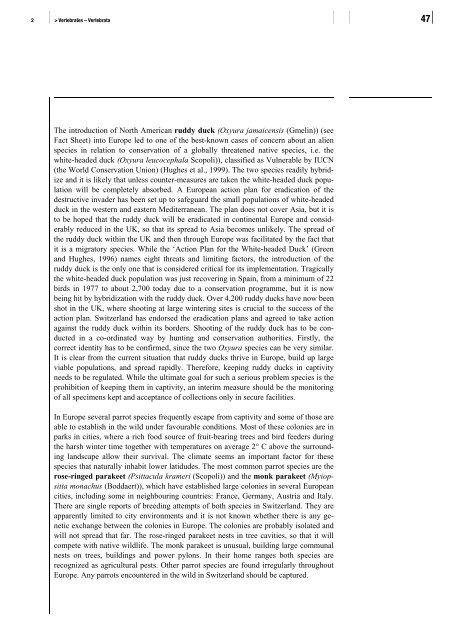Invasive alien species in Switzerland - Schweizer ...
Invasive alien species in Switzerland - Schweizer ...
Invasive alien species in Switzerland - Schweizer ...
You also want an ePaper? Increase the reach of your titles
YUMPU automatically turns print PDFs into web optimized ePapers that Google loves.
2 > Vertebrates – Vertebrata 47<br />
The <strong>in</strong>troduction of North American ruddy duck (Oxyura jamaicensis (Gmel<strong>in</strong>)) (see<br />
Fact Sheet) <strong>in</strong>to Europe led to one of the best-known cases of concern about an <strong>alien</strong><br />
<strong>species</strong> <strong>in</strong> relation to conservation of a globally threatened native <strong>species</strong>, i.e. the<br />
white-headed duck (Oxyura leucocephala Scopoli)), classified as Vulnerable by IUCN<br />
(the World Conservation Union) (Hughes et al., 1999). The two <strong>species</strong> readily hybridize<br />
and it is likely that unless counter-measures are taken the white-headed duck population<br />
will be completely absorbed. A European action plan for eradication of the<br />
destructive <strong>in</strong>vader has been set up to safeguard the small populations of white-headed<br />
duck <strong>in</strong> the western and eastern Mediterranean. The plan does not cover Asia, but it is<br />
to be hoped that the ruddy duck will be eradicated <strong>in</strong> cont<strong>in</strong>ental Europe and considerably<br />
reduced <strong>in</strong> the UK, so that its spread to Asia becomes unlikely. The spread of<br />
the ruddy duck with<strong>in</strong> the UK and then through Europe was facilitated by the fact that<br />
it is a migratory <strong>species</strong>. While the ‘Action Plan for the White-headed Duck’ (Green<br />
and Hughes, 1996) names eight threats and limit<strong>in</strong>g factors, the <strong>in</strong>troduction of the<br />
ruddy duck is the only one that is considered critical for its implementation. Tragically<br />
the white-headed duck population was just recover<strong>in</strong>g <strong>in</strong> Spa<strong>in</strong>, from a m<strong>in</strong>imum of 22<br />
birds <strong>in</strong> 1977 to about 2,700 today due to a conservation programme, but it is now<br />
be<strong>in</strong>g hit by hybridization with the ruddy duck. Over 4,200 ruddy ducks have now been<br />
shot <strong>in</strong> the UK, where shoot<strong>in</strong>g at large w<strong>in</strong>ter<strong>in</strong>g sites is crucial to the success of the<br />
action plan. <strong>Switzerland</strong> has endorsed the eradication plans and agreed to take action<br />
aga<strong>in</strong>st the ruddy duck with<strong>in</strong> its borders. Shoot<strong>in</strong>g of the ruddy duck has to be conducted<br />
<strong>in</strong> a co-ord<strong>in</strong>ated way by hunt<strong>in</strong>g and conservation authorities. Firstly, the<br />
correct identity has to be confirmed, s<strong>in</strong>ce the two Oxyura <strong>species</strong> can be very similar.<br />
It is clear from the current situation that ruddy ducks thrive <strong>in</strong> Europe, build up large<br />
viable populations, and spread rapidly. Therefore, keep<strong>in</strong>g ruddy ducks <strong>in</strong> captivity<br />
needs to be regulated. While the ultimate goal for such a serious problem <strong>species</strong> is the<br />
prohibition of keep<strong>in</strong>g them <strong>in</strong> captivity, an <strong>in</strong>terim measure should be the monitor<strong>in</strong>g<br />
of all specimens kept and acceptance of collections only <strong>in</strong> secure facilities.<br />
In Europe several parrot <strong>species</strong> frequently escape from captivity and some of those are<br />
able to establish <strong>in</strong> the wild under favourable conditions. Most of these colonies are <strong>in</strong><br />
parks <strong>in</strong> cities, where a rich food source of fruit-bear<strong>in</strong>g trees and bird feeders dur<strong>in</strong>g<br />
the harsh w<strong>in</strong>ter time together with temperatures on average 2° C above the surround<strong>in</strong>g<br />
landscape allow their survival. The climate seems an important factor for these<br />
<strong>species</strong> that naturally <strong>in</strong>habit lower latidudes. The most common parrot <strong>species</strong> are the<br />
rose-r<strong>in</strong>ged parakeet (Psittacula krameri (Scopoli)) and the monk parakeet (Myiopsitta<br />
monachus (Boddaert)), which have established large colonies <strong>in</strong> several European<br />
cities, <strong>in</strong>clud<strong>in</strong>g some <strong>in</strong> neighbour<strong>in</strong>g countries: France, Germany, Austria and Italy.<br />
There are s<strong>in</strong>gle reports of breed<strong>in</strong>g attempts of both <strong>species</strong> <strong>in</strong> <strong>Switzerland</strong>. They are<br />
apparently limited to city environments and it is not known whether there is any genetic<br />
exchange between the colonies <strong>in</strong> Europe. The colonies are probably isolated and<br />
will not spread that far. The rose-r<strong>in</strong>ged parakeet nests <strong>in</strong> tree cavities, so that it will<br />
compete with native wildlife. The monk parakeet is unusual, build<strong>in</strong>g large communal<br />
nests on trees, build<strong>in</strong>gs and power pylons. In their home ranges both <strong>species</strong> are<br />
recognized as agricultural pests. Other parrot <strong>species</strong> are found irregularly throughout<br />
Europe. Any parrots encountered <strong>in</strong> the wild <strong>in</strong> <strong>Switzerland</strong> should be captured.
















